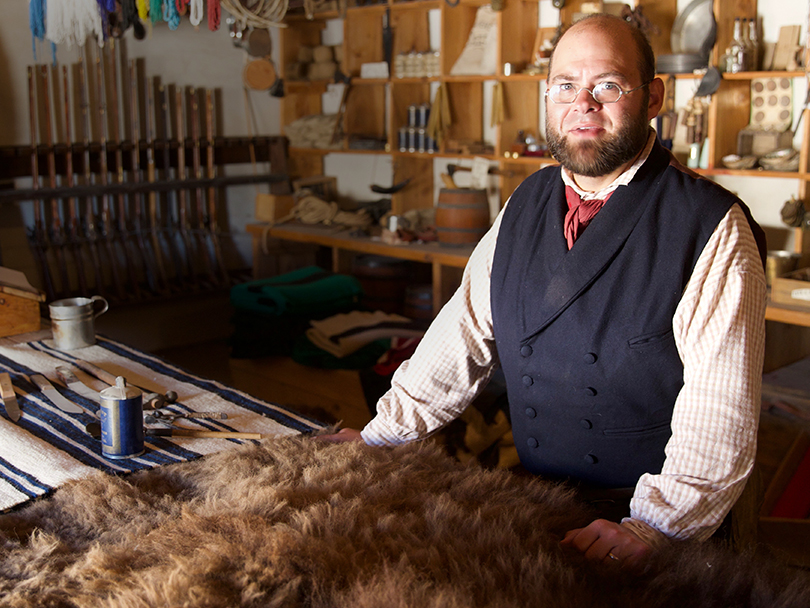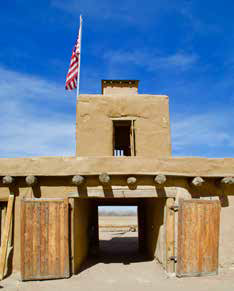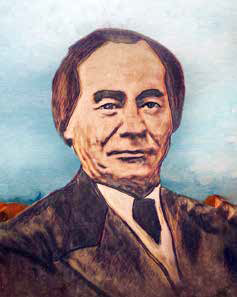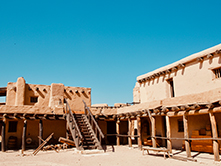Photos and story by Matt Vincent –
Bent’s Fort was once the only American building located between the Missouri River and the Pacific Ocean, a lone structure in the vast western interior of North America. Built in 1833 on the north side of the Arkansas River as part of the first business venture of Bent, St. Vrain & Company in what would someday become the American Southwest, it was a simple two-story structure built of adobe bricks and rough-hewn logs all covered with a reddish-brown stucco finish.
From the early 1830s to the late 1840s, the original fort, whose replica now stands on the plains outside of La Junta in Southeast Colorado Power Association’s territory, would become one of the important places in the western half of the expanding United States, coveted by friends and enemies: a multicultural epicenter of what America was once and what it eventually became.
One could stand in the doorway of its heavily fortified entrance to observe the traffic on the Santa Fe Trail. During its heyday, long trains of freight wagons hauled by massive teams of oxen would pause outside the gate to rest and resupply on the 1,000-mile journey. One would have seen mule skinners adjusting packs and panniers, pack trains of horses and riders, and mountain men clad in greasy buckskins — frontiersmen such as Kit Carson and Thomas “Broken Hand” Fitzpatrick.
Southern Cheyenne chiefs such as White Antelope, Black Kettle and Yellow Wolf, together with Arapaho leaders such as Left Hand and Little Raven, would ride into Bent’s Fort, proudly leading villages and horse herds, knowing William Bent’s home was built on the promise of peace. Unlike other frontier forts and supply stations that would later be constructed on the Smoky Hill Road in neighboring Kansas, Bent’s Fort was never attacked by Native Americans. In fact, William Bent and his brothers and business partner, Ceran St. Vrain, befriended the Plains Indians and did their best to protect them until the bitter end.
Throughout the spring and summer months during that time, wagons hauled tons of trade goods west from places like St. Louis, Independence, Fort Osage and Old Franklin — spices, foods, bolts of cloth, gunpowder, steel tools and even strange, expensive curios from as far away as New York, London and Paris. Utilitarian products such as steel knives and metal kettles were traded by Bent’s company for meticulously tanned buffalo hides and furs from the native tribes.
The remainder of the valuable freight was destined for Santa Fe and the lucrative Mexican trade center at the foot of the distant Sangre de Cristo Mountains. Meanwhile, wagons returning east carried their profits of silver coins and bullion. Others would leave Bent’s Fort loaded with compressed bales of bison hides. Private enterprise ran in both directions on the Santa Fe Trail through Bent’s Fort.
The profit potential was staggering, tempting thousands of Americans, French and Mexicans onto this well-traveled and sometimes dangerous frontier trail. How tempting? In 1821 when William Becknell first ventured west to trade in Santa Fe after Mexico had gained its independence from Spain, his paltry pack train carried only $300 worth of trade goods, but it fetched a $6,000 profit in Mexican silver. When the “Father of the Santa Fe Trail” returned the following year with investors and a wagon train carrying $3,000 in goods, his profits skyrocketed to $91,000, sparking a booming international trade market that would last until 1846 when the Mexican-American War changed all that.
There were two primary roads to Santa Fe in the beginning. Becknell blazed the Cimarron Route on his return to the Missouri River in 1822 because the southern route offered a shorter, smoother road to Santa Fe for heavily burdened freight wagons. Quicker was not always better, however, because reliable sources of water for the livestock were sometimes nonexistent. More, the threat of attack from Comanche and Kiowa tribes was ever present. Because of these inherent dangers, the so-called Mountain Route through what would someday become southern Colorado along the Arkansas eventually became the preferred path across the Great Plains and into the relatively uncharted western mountains.
“After traveling for two months or more, it must have been an amazing sight to see Bent’s Fort, a bustling crowd of people gathered in and around the fort,” said Jake Koch of the U.S. National Park Service at Bent’s Old Fort National Historic Site. Setting the scene in the wide valley above and below the trading post, Koch said, once would have been large herds of Indian ponies and the stark-white lodges of Plains Indians, all gathered in relative peace to trade, barter and exchange information.
“It was a giant melting pot of people and cultures. You might hear six or seven different languages spoken on any given day,” Koch continued, “and travelers were provided with amenities like a fully stocked mercantile store, a blacksmith, a carpentry shop — virtually everything they might need for the rest of their journey to Santa Fe or back to St. Louis.”
Mexico began on the opposite bank of the Arkansas River, of course. So, too, did Comancheria, the homeland of the Comanche empire, encompassing a large portion of modern Texas, Oklahoma and New Mexico. Mingling with Spanish, Mexican, French and English citizens inside Bent’s Fort were Cheyenne, Arapaho, Sioux, Kiowa and other tribes.
“Up until the war breaks out with Mexico, everybody here was generally getting along with one another,” Koch said. “So, for an all-too-brief time in western history, maybe a dozen years, Bent’s Fort was a unique place in what came to be known as the Wild West.”
The violence and tragedy would come not long after the Mexican-American War and culminate with the Plains Indian War in the aftermath of the nearby Sand Creek Massacre near present-day Eads.
As the nation observes the bicentennial anniversary of the Santa Fe Trail this year, Bent’s Old Fort will once again become a multicultural epicenter on Colorado’s southern plains when people from across the nation will gather for an event called “The Santa Fe Trail Lives On: 200 Years of Commerce and Cultural Connections.” Everything will take place September 22–26 at the historic site on the Arkansas River and in nearby La Junta.
“This is going to be major event,” said Stuart West, the new superintendent at Bent’s Old Fort National Historic Site. In fact, West hopes it will become much more than a week’s celebration of the Santa Fe Trail’s 200th anniversary, “I hope it is a discovery of southeastern Colorado —Boggsville, Fort Lyon, Bent’s Old Fort and the Sand Creek Massacre — so that when people think of Bent’s Old Fort, they understand its link to the whole region.”
Years of planning went into this upcoming event spearheaded by the Santa Fe Trail Association and the centerpiece of all those plans will be the Santa Fe Trail Bicentennial Symposium and its impressive lineup of distinguished speakers. Among those speakers are Dr. David Beyreis, who will discuss his 2020 book, Blood in the Borderlands: Conflict, Kinship, and the Bent Family, 1821-1920; and Aaron Mahr, a noted authority and historian from the University of New Mexico who is presently the superintendent of the National Park Service’s National Trails Office.
“The lineup is pretty incredible,” said LaDonna Hutton of Rocky Ford, a longtime member of Bent’s Fort Chapter of the SFTA who was quick to credit others for what she and her volunteer organization helped put together for history enthusiasts. In addition to LaDonna and her husband, Charlie, others warranting credit for this five-day immersion into the early 19th century include Kevin Lindahl, the president of the association’s Bent’s Fort Chapter, and John Carson, former interpreter at the fort who also happens to be the great-grandson of Kit Carson, an employee and longtime friend of William Bent. Kit Carson was also a one-time resident of Boggsville near the confluence of the Arkansas and the Purgatoire River a few miles south of Las Animas.
Although assembled for national and international members of the SFTA, the symposium is open to the public. And Hutton said one of the most highly anticipated days will be Friday, September 24, when attendees can experience what life was like in 1846 at Bent’s Fort on the Arkansas River.
“We’re planning to have more than 50 living historians in period dress (costume) at the fort throughout the week,” Hutton explained. “On Friday there will be demonstrations by many of the volunteers. And people will be able to see mountain men, fur traders, freighters and others involved in this important era of American history. It should be really fun, especially for young people, and we’re encouraging families to attend.”
Dozens of artists, authors, musicians, craftsmen and vendors will be on hand throughout the week, adding to the Old West atmosphere, and its history will once again rise like campfire smoke into the tall cottonwoods along the Arkansas River. Hutton recommends visitors register for the 2021 Santa Fe Trail Bicentennial Symposium prior to arrival to ensure reserved seating and other associated benefits, due to anticipated demand and limited seating at some of the venues. Local guided tours to other venues, which will include transportation, lunches and refreshments, are limited so advance registration is suggested.
For registration information, a complete schedule of events and other planned activities, visit the symposium website at www.2021sfts.com.
Photographer and writer Matt Vincent is a longtime resident of northeastern Colorado and is an avid history buff. His first book, Wild Times & True Tales from the High Plains, was released earlier this year.
Timeline of Bent’s Old Fort
1832: With the blessing and encouragement of the Southern Cheyenne Indians, William Bent, his older brother, Charles, and fellow St. Louis fur trader and entrepreneur, Ceran St. Vrain, make plans for a trading post on the Santa Fe Trail.
1833: Though still under construction, Bent’s Fort officially opens its doors for business. Kit Carson signs as a trader and takes a mule train of trade goods north to find the Cheyenne. In October, St. Vrain and William Bent ride for the Black Hills. By November, more than 350 lodges and 2,500 Southern Cheyenne Indians have drifted back south to the Arkansas and Bent’s Fort.
1841: The youngest of the four Bent brothers, Robert, is killed by Comanches while hunting buffalo along the Arkansas River.
1844: The dwindling demand for the beaver hat in the fashion centers of Europe and America craters the fur market. Beaver trapping is no longer profitable in the northern Rockies where the beaver population has been greatly reduced. The southern Rockies and desert Southwest now harbor the only reliable populations.
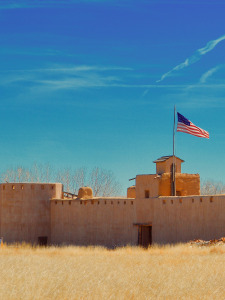 1846: Leading the Army of the West up the Santa Fe Trail into New Mexico, Gen. Stephan Watts Kearny uses Bent’s Fort as a stopover and resupply base. In a matter of weeks, he plants an American flag in Santa Fe, conquering this major Mexican trade center without firing a single shot. Before leaving for Arizona and California, Kearny appoints William Bent’s brother, Charles Bent of Taos, as the first American governor of the region.
1846: Leading the Army of the West up the Santa Fe Trail into New Mexico, Gen. Stephan Watts Kearny uses Bent’s Fort as a stopover and resupply base. In a matter of weeks, he plants an American flag in Santa Fe, conquering this major Mexican trade center without firing a single shot. Before leaving for Arizona and California, Kearny appoints William Bent’s brother, Charles Bent of Taos, as the first American governor of the region.
1847: Instigated by a small but powerful cadre of former Mexican officials, Charles Bent is assassinated during a bloody uprising of Pueblo Indians. Months later, William Bent’s Cheyenne wife, Owl Woman, dies in a Cheyenne village giving birth to his youngest son, Charlie, who is named after his older brother.
William Bent’s only surviving brother, George, dies at the fort in October following a long struggle with consumption, a disease known today as tuberculosis.
1849: William Bent and St. Vrain dissolve their partnership. Business at Bent’s Fort relies almost exclusively on the buffalo robe trade with the Plains Indians. Later that summer, while drying meat along the Platte not far from the newly opened Oregon-California Trail, the Cheyenne were hit by the “big cramps” (cholera), striking fear across the central plains. Yellow Woman, Bent’s second wife, flees to Bent’s Fort. The disease kills an estimated 50% of the Southern Cheyenne tribe before running its course. In late August, Bent rolls several kegs of gunpowder into his fort, sets the wooden roofs ablaze and destroys the fort.
1853: Bent’s New Fort is built downriver to serve as a trading post. It operates for several more years as tensions escalate between the Plains Indians and the U.S. government through a series of broken treaties. The new fort is sold to the U.S. military in 1859 and renamed Fort Wise.
1861: The new fort is renamed once more and becomes Fort Lyon.
1864: With the full support of the new territorial governor John Evans, Col. John M. Chivington and the 1st and 3rd Colorado Volunteers ride southeast to attack Cheyenne and Arapahoe camped at Sand Creek. William Bent’s son, Robert, is taken at gunpoint and forced to guide Chivington to the camp. On November 29, 1864, Chivington and his men slaughter more than 200 women and children.
1865: Despite all efforts to broker a peace agreement with the U.S. government and the Plains Indians, William Bent’s efforts fail. Full-scale war comes to the region.
1869: William, the last of the Bent brothers from St. Louis, dies at the age of 59, four days shy of his 60th birthday. And so, too, does any hope for a lasting peace between the whites and the Plains Indians.

